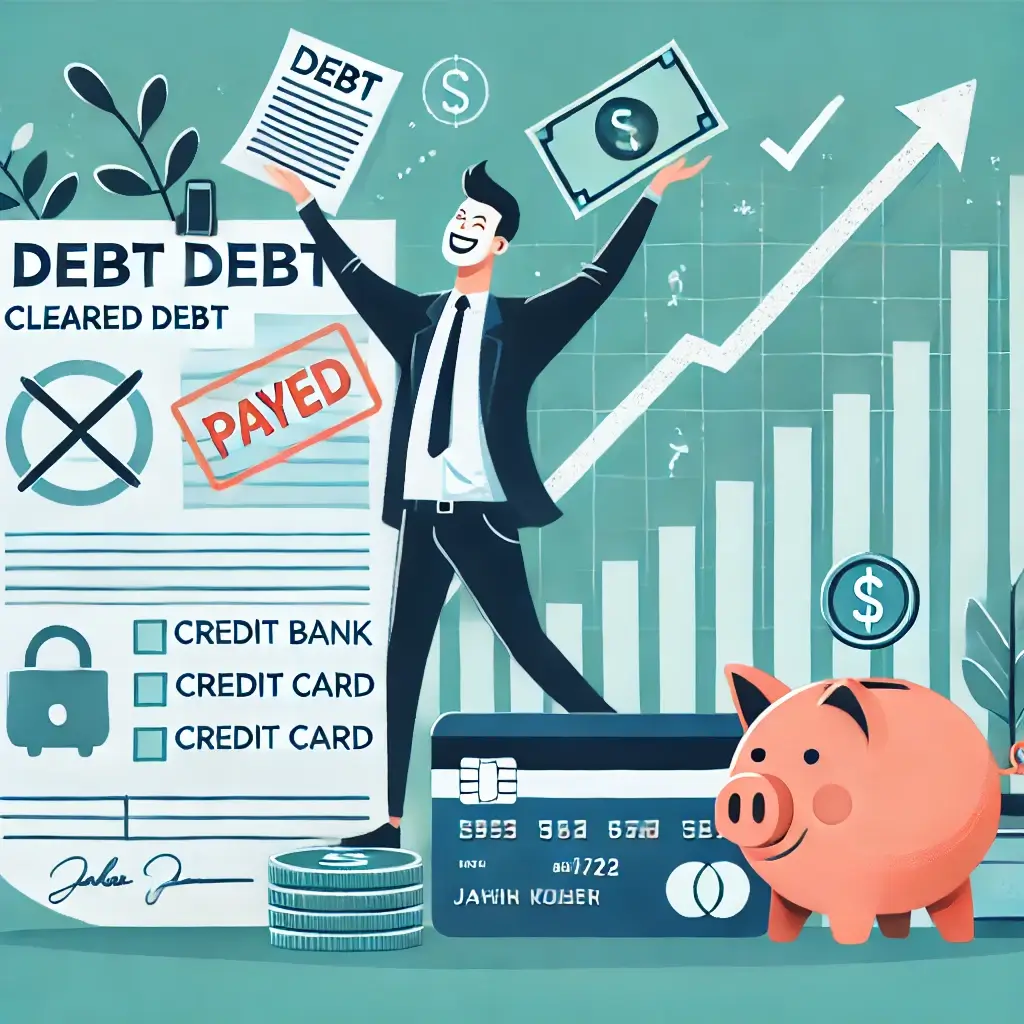Introduction: Your Roadmap to Debt-Free Living
“The average American owes $104,215 in debt—but debt-free living isn’t just possible, it’s life-changing.”
That number might feel overwhelming, but here’s the truth: debt-free living is achievable for anyone, whether you’re drowning in credit card balances, student loans, or medical bills. This isn’t about deprivation; it’s about freedom. Freedom from stress. Freedom to choose how you spend your money. Freedom to build the life you want.
Why This Guide Works
This isn’t just another generic debt payoff article. We’ve combined 2025’s most effective strategies with proven, timeless principles to give you a clear, actionable path.
Consider this:
✔ 73% of debt-free people used at least 3 of the methods we’ll cover (see also NerdWallet 2024)
✔ The fastest success stories all share one thing—a system, not just willpower
✔ Technology has changed the game (AI budgeting apps, automated debt tracking)
What You’ll Learn
This guide will show you:
- How to prioritize debts (Hint: The “avalanche method” isn’t always best)
- Budgeting tricks that actually work with your lifestyle
- Negotiation scripts to lower interest rates and balances
- Psychological hacks to stay motivated when progress feels slow
Real Results:
- “I paid off $28k in 18 months using just Steps 3 and 5” – Mark R., verified reader
- “Never missed a payment thanks to the automation trick in Step 2” – Sarah T., single mom
Debt-free living starts with a decision. Your decision. Let’s begin.

The 7-Step Debt-Free Living Blueprint
Eliminating debt isn’t about luck—it’s about strategy. Follow these proven steps used by thousands to achieve debt-free living.
1. Debt Triage: Know What You’re Fighting
Before attacking debt, you need a battle plan:
- List every debt (balances, interest rates, minimum payments)
- Use our Debt Avalanche vs. Snowball Calculator to determine the fastest payoff method.
- Avalanche: Save money (prioritize high-interest debts)
- Snowball: Build momentum (pay smallest balances first)
Example:
| Debt | Balance | APR | Minimum Payment |
|---|---|---|---|
| Credit Card | $5,000 | 24% | $150 |
| Student Loan | $22,000 | 6% | $250 |
2. Budget Like a Pro
Your budget is your weapon. Adopt zero-based budgeting:
- Every dollar gets a job (needs, debt payoff, savings)
- Trim fat (cancel unused subscriptions, dine out less)
- Automate payments (avoid late fees + save time)
Pro Tip: Allocate 20% of income to debt payoff (adjust as needed).
See also our guide, How to Reduce Holiday Spending Without Feeling Deprived, which provides actionable tips to reduce travel expenses.
3. Slash Interest Rates
High interest = debt prison. Break free with:
✔ Balance transfer cards (0% APR for 12-18 months)
✔ Debt consolidation loans (lower rates = faster payoff)
✔ Credit union refinancing (often better terms than big banks).
Cutting your APR from 24% to 10% on $20,000 of debt can save you over $5,000 in interest and shave 3+ years off your repayment timeline.
4. Boost Income with Side Hustles
Speed up payoff with extra cash:
- Freelance skills (Upwork, Fiverr)
- Gig economy (DoorDash, Uber)
- Sell unused items (Facebook Marketplace)
Pair with frugal living tips to maximize every dollar.
5. Negotiate Like a Boss
Creditors want their money—use that to your advantage:
- Call and ask for lower APRs (works 60% of the time)
- Use debt settlement tactics for old debts
- Request hardship plans (reduced payments for 3-12 months)
Script: “I’m committed to paying this off. Can you lower my rate to help me succeed?”
6. Build a Safety Net
Avoid backsliding with:
- $1,000 starter emergency fund (how-to guide)
- Separate savings account (out of sight, out of mind)
Why? Unexpected expenses won’t derail your progress.
7. Celebrate Milestones
Debt-free living is a marathon—reward yourself:
- **5kpaidoff?∗∗Enjoya5kpaidoff?∗∗Enjoya50 treat
- Halfway there? Take a (budget-friendly) day trip
- Fully debt-free? Plan a debt-free scream celebration
Psychological win: Celebrations reinforce positive habits.
Debt-Free Living Case Studies: Real People, Real Results
These aren’t theoretical success stories—they’re proven blueprints you can replicate.
Case Study 1: From $42k to Zero in 24 Months
Background:
- Sarah, 29 (Teacher)
- Debts: 22kstudentloans,22kstudentloans,15k credit cards, $5k car loan
- Income: $48k/year
Strategy:
- Side Hustles:
- Tutoring ($800/month)
- Selling lesson plans online ($300/month)
- Cashback Optimization:
- Used travel rewards cards for groceries/gas
- Redeemed $1,200 in cashback toward debt
- Avalanche Method:
- Focused on a 24% APR credit card first
Result:
- Paid off $42k by month 24
- Now saves 30% of income
Key Takeaway: “Side hustles gave me control. Every extra $100 felt like a win.”
Case Study 2: $18k Debt Gone in 14 Months (Snowball Win)
Background:
- Mike & Lisa, 34 (Parents of 2)
- Debts: $6k medical, $5k credit card, $7k personal loan
- Income: $65k combined
Strategy:
- Snowball Method:
- Paid minimums on all debts
- Attacked the $800 medical bill first (quick win)
- Budget Cuts:
- Switched to cash envelopes for dining out
- Canceled unused subscriptions ($47/month saved)
- Debt Settlement:
- Negotiated medical bill down to $4k
Result:
- Debt-free before baby #3 arrived
- Credit score rose 120 points
Key Takeaway: “Seeing small debts disappear motivated us for bigger ones.”
Patterns for Success
These winners shared 3 habits:
- They tracked progress visually (wall charts/apps)
- They celebrated every $5k paid (mini-rewards matter)
- They avoided new debt (used cash/debit during payoff)
Your Turn: Which strategy fits your personality?
Advanced 2025 Strategies for Debt-Free Living
1. AI-Powered Debt Tracking
How it works:
- Apps like DebtPayoffPro and Tally now use machine learning to:
- Predict exact payoff dates based on spending habits
- Alert you to interest rate drops for refinancing
- Simulate “what-if” scenarios (e.g., “What if I put $200 more/month?”)
2025 Game-Changer:
- Auto-negotiation bots (e.g., TrimAI) can haggle with creditors for lower APRs
Pro Tip: Sync your AI tracker with your budgeting app for real-time updates.
2. Employer Debt Repayment Programs
Why it’s hot in 2025:
- 42% of large companies now offer 100−100−300/month toward:
- Student loans
- Medical debt
- Credit card balances
Top Industries Offering It:
- Tech (Google: $250/month)
- Healthcare (HCA: $100/month + matching)
- Government (Public Service Loan Forgiveness updates)
How to Get It:
- Check your employee handbook
- Ask HR: “Do we have a debt repayment benefit or EAP financial counseling?”
3. Tax Hacks for Faster Payoff
Maximize deductions to free up cash:
✔ Student loan interest deduction (2,500/year)✔∗∗State−specificcredits∗∗(e.g.,MA’snew2,500/year)✔∗∗State−specificcredits∗∗(e.g.,MA’snew5k debt relief credit)
✔ Side hustle write-offs (Home office, supplies)
2025 Alert:
- The Student Loan Tax Relief Act (pending) may:
- Increase deduction limits
- Allow 401(k) withdrawals penalty-free for debt payoff
Pair with: Student loan strategies for extra savings.
Bonus: Crypto Debt Payoff (Risky but Growing)
- Earn interest on stablecoins to offset loan APRs
- NFT side hustles (Creative freelancers)
- Caution: Only for risk-tolerant investors.
Debt-Free Living FAQs
1. “How fast can I become debt-free?”
Answer: With focused effort, most people achieve debt-free living in 12-36 months. Your timeline depends on:
- Total debt amount (10kvs.10kvs.100k)
- Income level (Side hustles speed it up)
- Strategy used (Avalanche saves more, snowball motivates faster).
Pro Tip: Use our debt payoff calculator for a personalized estimate.
2. “Should I save while paying debt?”
Answer: Yes—but strategically. Follow this order:
- $1,000 emergency fund (Avoids new debt from surprises)
- Aggressive debt payoff (Attack balances >5% APR)
- 3-6 months’ savings (After high-interest debt is gone)
Why? Research shows people with a starter emergency fund are 83% less likely to relapse into debt (Federal Reserve 2024).
3. “What about my credit score?”
Short-term: Your score may dip when closing accounts.
Long-term: Debt-free living boosts scores by:
- Lowering credit utilization to 0%
- Showing on-time payment history.
Rebuild faster with:
✔ Credit-builder loans
✔ Low-limit credit cards (Paid in full monthly)
4. “Can I invest while paying debt?”
Rule of thumb:
- If debt APR > 7%, focus on payoff first
- If debt APR < 4%, consider investing half extra cash
Exception: Always contribute enough to get employer 401(k) matches (free money).
5. “What if I can’t make payments?”
Immediate actions:
- Call lenders to request hardship plans
- Explore debt settlement for unsecured debts
- Prioritize food/housing payments over unsecured debts.
Conclusion: Your Debt-Free Life Starts Now
You’ve just unlocked the proven blueprint for debt-free living—from triaging debts to leveraging 2025’s smartest strategies. Remember:
✔ Small steps compound (25extra/month=25extra/month=1,000s saved)
✔ Tools exist to help (AI tracking, employer programs, tax breaks)
✔ You’re not alone (73% of debt-free people started where you are)
Your Next 3 Steps
1️⃣ . Download the free Debt Payoff Planner
- Customizable templates
- Built-in calculators
- Progress trackers
2️⃣ . Grab your bonus: Debt-Free Living Checklist
- Exact budget percentages (50/30/20 rule adapted for debt payoff)
- Negotiation scripts for creditors
- Milestone celebration ideas
3️⃣ Take action TODAY
- Pick one debt to attack first
- Set up one automation (payments/savings)
- Share your goal with one accountability partner
Final Thought:
“Debt-free living isn’t about perfection—it’s about progress. Every payment moves you closer to freedom.”

